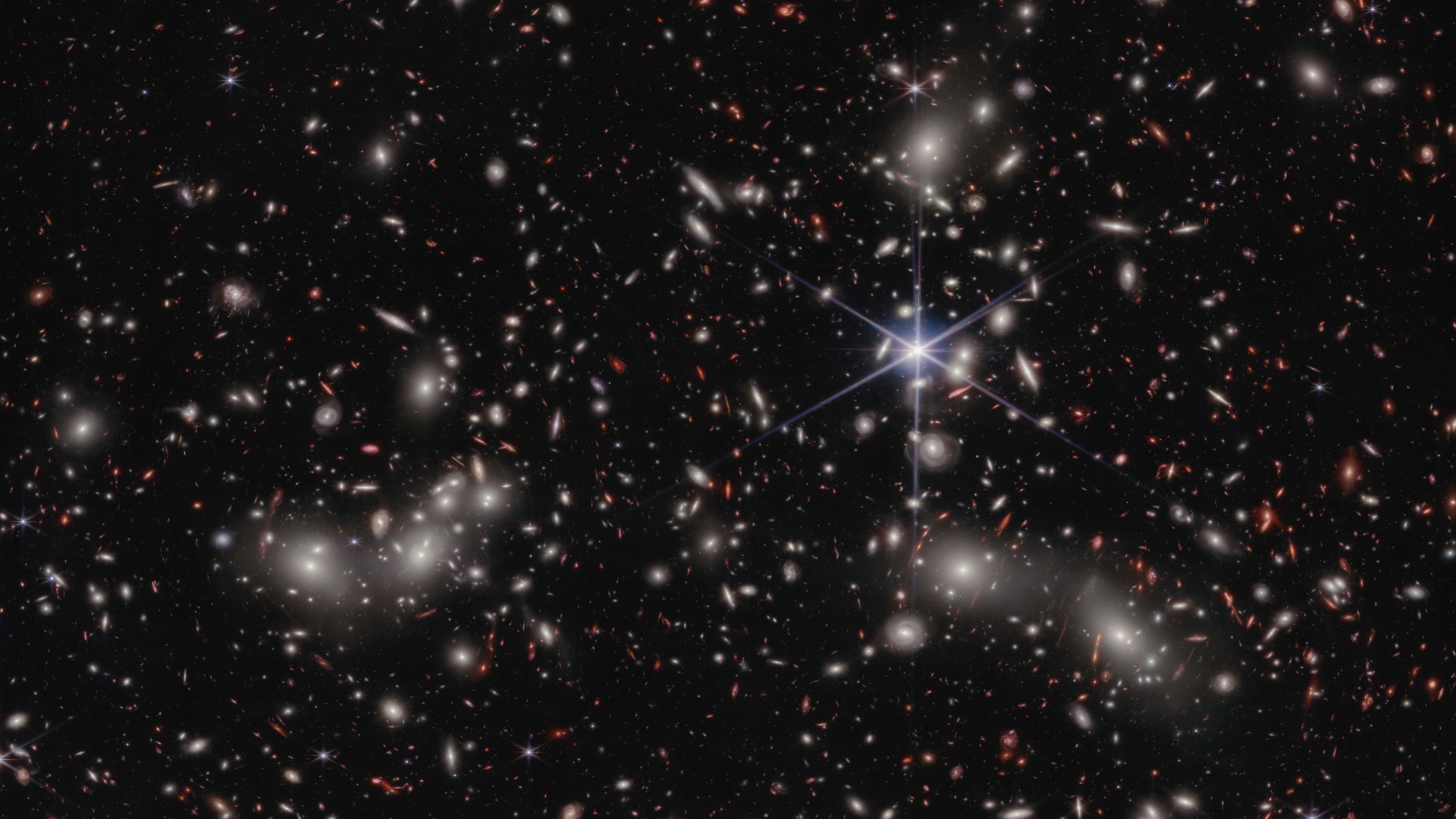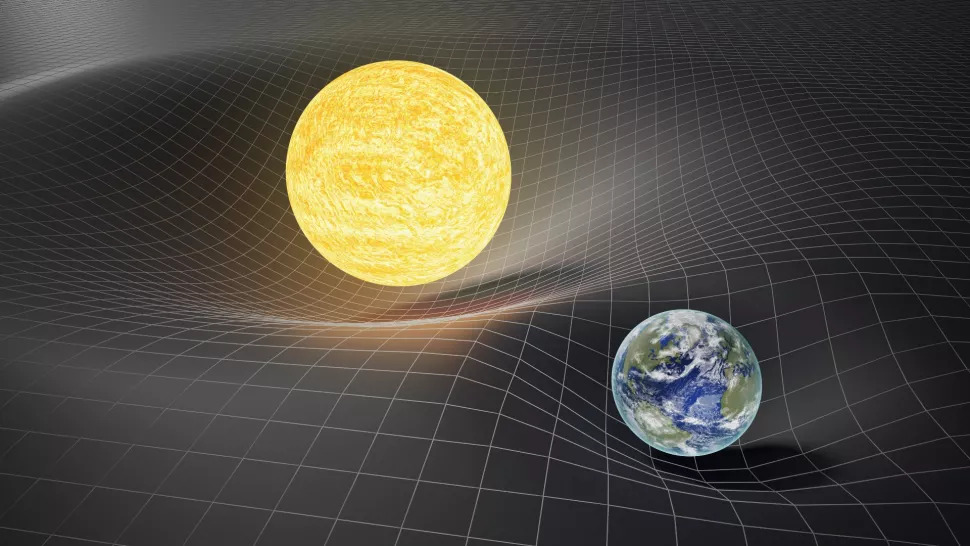James Webb Space Telescope opens Pandora's Cluster in stunning image with help from Einstein (video)
The powerful space telescope was able to see three clusters of galaxies in the region, also known as Abell 2744, merging to form a "mega cluster."
In Greek mythology, Pandora's curiosity leads her to open a container that releases all of the evils and hardships that now exist in the world.
Let's hope the James Webb Space Telescope (JWST) didn't do just that as it zoomed in on a region of space called "Pandora's Cluster" using a phenomenon predicted by Einstein in 1915. The new JWST image reveals previously hidden details from the region and the merger of three already massive clusters to create an even larger "mega cluster" of galaxies.
The nickname for this region, formally known as Abell 2744, of Pandora's Cluster arises from the observation of an assortment of different structures within it. Yet, only the central core of this region of space has been studied previously by the Hubble Space Telescope, meaning plenty of secrets were left undiscovered when the JWST turned its powerful infrared instruments to the area.
Related: NASA's James Webb Space Telescope: The ultimate guide

The JWST team looked at Pandora's Cluster using the powerful telescope's Near-Infrared Camera (NIRCam) and the Near-Infrared Spectrograph (NIRSpec) instruments as part of the Ultradeep NIRSpec and NIRCam ObserVations before the Epoch of Reionization (UNCOVER) program. The deep field image that resulted from this takes four JWST "snapshots" and stitched them together. This created one panoramic image featuring a stunning 50,000 sources of infrared light.
This led to a deep-field image of Pandora's Cluster, located around 3.5 billion light-years away, that achieved an impressive balance of breadth and depth that could revolutionize the study of galactic evolution.
Prominent in the image is a bright star foreground star from the Milky Way with distinctive diffraction spikes created by the JWST. Around this are bright sources of white light that are surrounded by a hazy glow; these are the much more distant galaxies of Pandora's Cluster.
Get the Space.com Newsletter
Breaking space news, the latest updates on rocket launches, skywatching events and more!
Though human-created technology is essential to the observation of this cluster of clusters, astronomers also relied on a natural phenomenon first revealed by Albert Einstein in his 1915 opus, the theory of gravity known as general relativity.
Einstein provides the key to opening Pandora's Cluster
General relativity predicts that objects of mass have an effect on the very fabric of space, warping it. This is analogous to placing objects on a stretched rubber sheet and creating dents in the sheet. Just like balls of increasing mass would create larger, more extreme dents in that sheet, cosmic objects of tremendous mass create large warps in the fabric of space. This curvature can be so extreme that as light passes it, its path is also curved.

That means if light from a background object passes a body of extreme mass in the foreground as it travels to Earth, the background object can appear to have shifted position in the sky. This gravitational lensing effect can have other consequences too. Sometimes the foreground mass object or "lensing object" can actually help amplify the light from background objects.
This amplification helps the already powerful JWST see the light from distant and therefore early galaxies that without lensing may be too faint to observe. The lensing can also distort background objects, stretching them like cosmic taffy as a result of their light taking different paths with different travel times around the lensing object. This distortion helps astronomers determine which galaxies are in the foreground and which are in the background.
An example of this can be seen in the new JWST image of the patch of the sky including Pandora's Cluster. In the lower right of the image are hundreds of distant strongly lensed galaxies appearing as arcs of light. These galaxies have never been seen before, even by Hubble.
The image was created when NIRCam captured Pandora's Cluster with exposures lasting between 4 to 6 hours and a total of 30 hours of observations. These observations will now be followed up by an analysis of the region using NIRSpec, which will provide detailed measurements of distances within the cluster and details about the composition of its constituent galaxies.
This new data, set to be revealed this summer, should reveal entirely new insights into how galaxies came together in the early universe and how they evolved to form the cosmos we see around us today.
Follow us on Twitter @Spacedotcom or on Facebook.
Join our Space Forums to keep talking space on the latest missions, night sky and more! And if you have a news tip, correction or comment, let us know at: community@space.com.

Robert Lea is a science journalist in the U.K. whose articles have been published in Physics World, New Scientist, Astronomy Magazine, All About Space, Newsweek and ZME Science. He also writes about science communication for Elsevier and the European Journal of Physics. Rob holds a bachelor of science degree in physics and astronomy from the U.K.’s Open University. Follow him on Twitter @sciencef1rst.
-
Pentcho Valev " Gravitational lensing first proposed by Soldner (1801) in context of Newtonian theory. He found a deflection angle...For sun gives 0.85”...Einstein derived same result in 1911 using Equivalence principle & Euclidean metric...In 1915 with general relativity, Einstein derived the new result...For sun gives 1.7” " https://lweb.cfa.harvard.edu/~dfabricant/huchra/ay202/lectures/lecture12.pdfReply
It is obvious that light deflects as per Newton, not as per Einstein:
"To see WHY A DEFLECTION OF LIGHT WOULD BE EXPECTED, consider Figure 2-17, which shows a beam of light entering an accelerating compartment. Successive positions of the compartment are shown at equal time intervals. Because the compartment is accelerating, the distance it moves in each time interval increases with time. The path of the beam of light, as observed from inside the compartment, is therefore a parabola. But according to the equivalence principle, there is no way to distinguish between an accelerating compartment and one with uniform velocity in a uniform gravitational field. We conclude, therefore, that A BEAM OF LIGHT WILL ACCELERATE IN A GRAVITATIONAL FIELD AS DO OBJECTS WITH REST MASS. For example, near the surface of Earth light will fall with acceleration 9.8 m/s^2." http://web.pdx.edu/~pmoeck/books/Tipler_Llewellyn.pdf
James Hartle, Gravity: An Introduction to Einstein's General Relativity, p. 113: "Light falls in a gravitational field with the same acceleration as material bodies." https://www.amazon.com/Gravity-Introduction-Einsteins-General-Relativity/dp/0805386629
Eddington's crime:
Frederick Soddy, An Address to the fourth Conference of Nobel Prizewinners at Lindau (Bodensee), S. Germany, 30.VI.1954: "Incidentally the attempt to verify this during a recent solar eclipse, provided the world with the most disgusting spectacle perhaps ever witnessed of the lengths to which a preconceived notion can bias what was supposed to be an impartial scientific inquiry. For Eddington, who was one of the party, and ought to have been excluded as an ardent supporter of the theory that was under examination, in his description spoke of the feeling of dismay which ran through the expedition when it appeared at one time that Einstein might be wrong! Remembering that in this particular astronomical investigation, the corrections for the normal errors of observation - due to diffraction, temperature changes, and the like - exceeded by many times the magnitude of the predicted deflection of the star's ray being looked for, one wonders exactly what this sort of "science" is really worth." http://www.reformation.edu/scripture-science-stott/aarch/pages/10-soddy-to-nobel-prizewinners.htm
Sabine Hossenfelder: "As light carries energy and is thus subject of gravitational attraction, a ray of light passing by a massive body should be slightly bent towards it. This is so both in Newton's theory of gravity and in Einstein's, but Einstein's deflection is by a factor two larger than Newton's. As history has it, Eddington's original data actually wasn't good enough to make that claim with certainty. His measurements had huge error bars due to bad weather and he also might have cherry-picked his data because he liked Einstein's theory a little too much. Shame on him." http://backreaction.blogspot.com/2015/04/a-wonderful-100th-anniversary-gift-for.html









